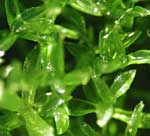 The moss Physcomitrella patens is becoming widely recognized as an experimental organism of choice not only for basic molecular, cytological, and developmental questions in plant biology, but also as a key link in understanding plant evolutionary questions, especially those related to genome evolution. Physcomitrella is well placed phylogenetically to provide important comparisons with the flowering plants. In terms of evolutionary distance, Physcomitrella is to the flowering plants what Drosophila is to humans. Having the full Physcomitrella genome available will greatly inform bioinformatic comparisons and functional genomics in plants, just as the mouse, Fugu, and Drosophila genomes have informed animal biology.
The moss Physcomitrella patens is becoming widely recognized as an experimental organism of choice not only for basic molecular, cytological, and developmental questions in plant biology, but also as a key link in understanding plant evolutionary questions, especially those related to genome evolution. Physcomitrella is well placed phylogenetically to provide important comparisons with the flowering plants. In terms of evolutionary distance, Physcomitrella is to the flowering plants what Drosophila is to humans. Having the full Physcomitrella genome available will greatly inform bioinformatic comparisons and functional genomics in plants, just as the mouse, Fugu, and Drosophila genomes have informed animal biology.
There is strong scientific interest in Physcomitrella worldwide and a good genomic infrastructure, including ESTs; BAC, cDNA, and insert libraries; RNA interference lines; and an Agilent gene chip. These resources are gaining usage within the wider plant community for comparative genomic and gene expression studies.
Physcomitrella’s simple morphology allows informative imaging of tagged macromolecules and the direct observation in vivo of intracellular processes involved in tip growth and the positioning of the plane of cell division–key processes in plant morphogenesis. These methods are allowing the study in moss of critical higher plant processes, e.g. phytohormone signalling (i.e. auxin, cytokinin and especially abscisic acid), cell polarity, tropisms, and photomorphogenesis (i.e. phytochrome and cryptochrome). Physcomitrella is the only plant that undergoes homologous recombination with a frequency that allows easy targeting of genes for replacement and elimination. This has been crucial for the development of other model systems such as yeast, allowing gene function in higher organisms to be predicted. A comprehensive genome sequencing project will allow scientists to make full use of the unique experimental system of Physcomitrella and to apply data from this organism to higher plant models such as Arabidopsis and rice.
CSP project participants: Brent D. Mishler (proposer, Univ. of California, Berkeley), Ralph S. Quatrano (proposer, Washington Univ.), David J. Cove (Washington Univ. and Leeds Univ.), Andrew C. Cuming (Leeds Univ.), Mitsuyasu Hasebe (Natl. Inst. for Basic Biology, Japan), and Ralf Reski (Univ. of Freiburg).